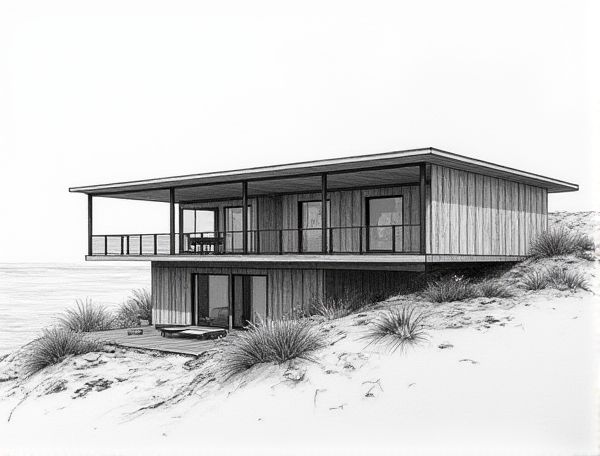
Photo illustration: Coastal home design with shou sugi ban wood cladding
Shou sugi ban wood cladding offers a unique blend of durability and aesthetic appeal, enhancing your coastal home design with its charred texture that withstands harsh seaside elements. Explore the article to discover how this traditional Japanese technique transforms coastal homes into stunning, weather-resistant retreats.
Introduction to Coastal Home Design
Coastal home design emphasizes natural light, airy spaces, and a palette inspired by the sea, sand, and sky to create a tranquil living environment. Key features include large windows for ocean views, durable materials resistant to salt and humidity, and open floor plans that enhance the flow of indoor and outdoor spaces. Incorporating elements like light woods, woven textures, and nautical accents ensures the design reflects the relaxed, breezy vibe of coastal living.
What Is Shou Sugi Ban Wood Cladding?
Shou Sugi Ban wood cladding is a traditional Japanese technique that involves charring the surface of cedar wood to enhance its durability and resistance to weather, insects, and fire. This method creates a unique, textured finish that ranges from deep black to rich charred brown, adding a striking aesthetic to modern and rustic home designs. The process not only preserves the wood but also reduces maintenance needs, making it a sustainable choice for exterior siding in various architectural styles.
Benefits of Shou Sugi Ban for Coastal Environments
Shou Sugi Ban, a traditional Japanese technique of charring wood, offers exceptional durability and resistance to moisture, mold, and pests, making it ideal for coastal environments. Its charred surface enhances wood's natural weatherproofing, extending the lifespan of exterior cladding and reducing maintenance costs in salty, humid conditions.
Enhancing Curb Appeal with Charred Wood Facades
Charred wood facades, known as Shou Sugi Ban, provide a unique blend of durability and aesthetic appeal that significantly enhance curb appeal. This traditional Japanese technique involves charring wood surfaces to create a striking black finish that resists weather, insects, and rot. Incorporating charred wood in home exteriors adds texture and depth, creating a bold statement that increases property value and visual interest.
Shou Sugi Ban: Durability Against Salt and Humidity
Shou Sugi Ban, a traditional Japanese wood preservation technique, significantly enhances durability by charring the wood surface, making it highly resistant to salt corrosion and humidity-induced decay. This carbonized layer acts as a protective barrier against moisture and salt damage, ideal for coastal and humid environments where wood longevity is critical.
Sustainability and Eco-Friendly Materials
Incorporating sustainably sourced materials such as bamboo, reclaimed wood, and recycled metal significantly reduces a home's ecological footprint while enhancing durability and aesthetic appeal. Utilizing energy-efficient insulation, low-VOC paints, and non-toxic finishes contributes to improved indoor air quality and long-term environmental health. Emphasizing passive solar design and water-saving fixtures further promotes resource conservation and lowers utility costs in eco-friendly home design.
Balancing Modern and Coastal Aesthetics
Incorporating natural materials such as driftwood, rattan, and reclaimed wood creates a seamless blend of modern and coastal aesthetics. Neutral color palettes with accents of seafoam green, navy blue, and sandy beige evoke a relaxing beach atmosphere within contemporary spaces. Minimalist furniture designs paired with textured fabrics and nautical-inspired decor elements emphasize both sophistication and coastal charm.
Maintenance Tips for Shou Sugi Ban Exteriors
Regularly inspect your Shou Sugi Ban exterior for debris or mold buildup to preserve its natural fire resistance and extend its lifespan. You should clean the surface gently with a soft brush and avoid harsh chemicals to maintain the wood's charred texture and rich aesthetic appeal.
Inspiring Coastal Homes Using Burned Wood Cladding
Burned wood cladding enhances coastal homes by providing natural durability against moisture and salty air while adding a striking, rustic aesthetic that complements oceanfront surroundings. Your home's exterior gains unique texture and weather resistance, creating an inspiring blend of tradition and modern coastal design.
Conclusion: Elevating Coastal Living with Shou Sugi Ban
Shou Sugi Ban enhances coastal living by providing durable, weather-resistant siding that withstands harsh marine environments while adding unique, natural elegance to home exteriors. This traditional Japanese wood preservation technique reduces maintenance needs and resists pests, mold, and fire, making it ideal for seaside homes. Incorporating Shou Sugi Ban elevates both the aesthetic appeal and longevity of coastal properties, blending sustainability with timeless design.
 homedesy.com
homedesy.com